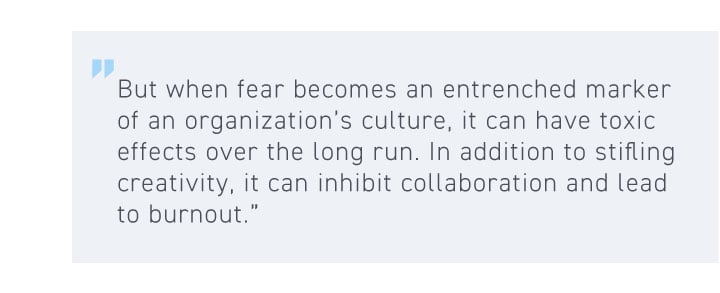Is it better to be feared or respected at work? Is cracking the whip harming your team’s productivity? Can managers force employees to produce their best work? Or should they instead create a positive and rewarding environment where a team can excel?
If you’re in leadership, the start of a new year may bring new budgets, challenges, and corporate mandates. All this newness and renewal makes it a good time to self-assess, whether by setting fresh goals or trying to change bad behaviors.
One bad behavior common to managers is leading with fear. Making employees fear penalties can be a short-term way to get everyone’s attention. However, studies tell us that this approach is short-sided. It often leads to a toxic work environment that kills motivation and retention. Leading with fear can also hurt the company’s bottom line.
What does it mean to lead with fear?

You may not even recognize that you’re a fear-based manager. Seriously, who would have the guts to point it out to you? Managers who lead with fear don’t just carry a big stick and lean more heavily toward punishment than reward, but they also use fear to try to control their workers.
You’ve probably had some experience with a bad manager (or managers). More than likely, fear was a primary component in making the manager bad. But here’s a secret that the manager wouldn’t want you to know: Fear-based managers are fearful themselves. They may fear the loss of control over their employees. They feel like they can't trust their workers, so micromanagement seems like the only option. Because everything in a corporate setting rolls downhill, these managers may be fearful about their job security. Their fear rolls into their employee relationships, the metrics and rules they set, and the demeanor they exhibit every day.
Here’s an example of how fear-based management kills innovation: The manager seeks input about an idea at a meeting where everyone (if they speak at all) voices their affirmation. But afterward, everyone has a side conversation about their true feelings and criticisms. No one feels comfortable challenging or offering suggestions to their manager in this environment. Every company needs people willing to speak up and express an opposing viewpoint. Otherwise, the company ends up with all “yes” people who just carry the party line, even when there are misgivings about what is expressed. The culture of fear has already taken hold.
The Culture of Fear
If you haven’t read The Culture of Fear by Barry Glassner, you’re missing out on an insightful glimpse into American life that is just as relevant today as it was when it first came out decades ago. The book is a study of fear as a manipulator in politics to create support for war, in advertising to drive consumerism, or to create other kinds of political, cultural, or workplace behavior.
Today, mass media is even closer than when Glassner wrote his book; our news feeds are real-time and hand-held, giving way to endless anxiety. Glassner’s goal was to make consumers critical of the stories that surround us and recognize that our fears are being manipulated for profit and political gain. This kind of manipulation works in both subtle and blatant ways in our culture. But how does fear impact the workplace when a manager uses it to bully his or her employees? If you’re a manager, what are the primary ways you’re trying to manipulate your employees into doing their jobs?
Managers and Fear Culture
If you’re living in a management culture of fear, it can be hard to see a way out of it, whether you’re the boss or employee. Changing the environment starts with recognizing the behaviors that created it.
There are three primary ways that employers intimidate managers and managers manipulate employees in a culture of fear:
- They create a fear of suffering, which could be a cut in pay or hours or the loss of a job. Or the suffering could be the higher-up yelling at or writing up the person lower on the corporate ladder.
- They might create fear of loss. This could involve the (spoken or unspoken) threat of a demotion or removal from a team. It could be a crackdown on working from home or some other real or perceived benefit, like work-life balance when employees are required to work late.
- They may create a fear of failure or inadequacy. Workers fear they will let the team down. Or, worse, managers could foster a culture of ridicule, bullying, chastisement, or outright failure. Fear-based managers can be sarcastic in meetings, tearing down workers in front of their peers.
Fear-based cultures are characterized by:
- Things that cannot be named. Everyone knows the problem, but no one talks about it. Therefore, things do not change.
- Employee mistakes are met with punishment, even if the rules aren’t properly spelled out. Threats, intimidation, manipulation, passive-aggressive behaviors—yes, you’ll find all of this in a fear culture.
- Micromanagement and metrics have replaced business strategies. Workers don’t know what they’re working for—but they know they have to hit the numbers.
- Communication silos kill transparency and create gangs of “in the know” employees.
If you’re a manager seeking long-term growth, you may recognize some of these scenarios. You may have created these environments, but the root cause may be because all of corporate culture is driven this way. Getting to the bottom of a fear culture requires that you recognize the motivators within yourself first. To do this, ask yourself these three questions:
- Are you afraid to present findings to corporate leadership? If you find yourself over-preparing because you’re not sure what curveball will come your way or if you spend a lot of time agonizing over how each slide will be perceived, you may be struggling under the same demotivating environment you’ve foisted on your employees.
- How worried are you that you’ll lose your job? If you as a manager feel that worry, imagine how your workers might feel. If your goal is simply to keep your head down and do your job, that’s a sign your environment is toxic and potentially fear-based.
- Are you comfortable challenging organizational leadership? Ask yourself if you feel comfortable asking, “Why?” If you don’t, your employees probably don’t either.
Living in a fear-based culture kills joy. It also prevents exciting innovations that help companies attain greater market share. If you think your emphasis on carrying a big stick is somehow helping you get the job done, check out what the research tells us.
Long-Term Effects of Leading with Fear
We still haven’t established why leading with fear is all that bad. In the book Drive: The Surprising Truth About What Motivates Us, Daniel Pink describes seven problems with fear culture in the workplace:
- Fear kills motivation
- Fear diminishes productivity
- Fear crushes creativity
- Fear crowds out good behavior
- Fear encourages cheating and other unethical behavior
- Fear fosters stressful, short-term thinking
- The negativity can become addicting
While you may consider these seven deadly sins as opinions, there is a strong body of scientific research showing that leading by fear does not help organizations in the long run. For example:
- Researchers at Harvard Law studied the correlation between authoritarian leadership and positive negotiation outcomes with teams. They found that, while few initially appreciate a “top-down” approach, this type of leadership backfires on making progressive progress every time. Without a collaborative workplace, the company will remain stagnant and behind the times, not to mention toxic. Clients will be likely to pursue other companies where win-win situations are the outcome.
- Another study in the Journal of Environmental Research and Public Health shows that toxic work environments continue to perpetuate toxic behavior—and it can be doubly hard for a company to recover. When behaviors like bullying, passive aggressiveness, and harassment become the norm in leadership, employees perpetuate those negative traits, resulting in a company that no one wants to work for.
To get the most from your employees, they need a safe space to share their ideas. We know that innovation requires making mistakes. Creating a culture that shuts down ideas and punishes mistakes will not save your company, it certainly will not endear you to your employees, and it won’t help you retain your top talent. If you’re starting to finally get the point that leading with fear is a bad idea, here are some ways to start shifting your leadership style.

6 Ways to Improve Your Toxic Culture
Change can start now, with you. If you’re a manager in a fear-based culture seeking to change interactions with your team, Forbes reports some best practices that you can initiate at the department level—no matter the size of your team or the bureaucracy around you:
- Set expectations for and with the team. Sit down and discuss job descriptions and individual and departmental goals in a way that gives employees a voice in the work.
- Open dialogue by reassuring employees that you will not retaliate against their suggestions or for speaking the truth. Create an open-door policy that allows people to speak freely without consequences.
- Be an active listener. If employee suggestions cannot be implemented, be as honest as you can about why or why not the idea can be used. Seek employee feedback regularly and pay attention to what it says about the workplace. Coach employees in one-on-one conversations to help them thrive; don’t threaten them or try to scare them into compliance.
- Recognize achievements and ideas more often than you discipline bad behavior. Set up new models to recognize innovation, initiative, and employee self-improvement, and watch what starts to happen.
- Address problems with a problem-solving attitude and growth mindset. Ask, “How can we do this better?” and “How can we ensure this doesn’t happen again?” Recognize that mistakes happen, but the best companies and the best people learn and grow by looking forward and getting better.
- Lead by example and genuinely thank everyone for their work, their effort, and their engagement. You may be surprised that this behavior may encourage employees to start managing up—a mutual benefit for you both!
Making a change toward a more positive leadership style will create an environment where your employees want to give you their best work. If you still feel a need to resort to scare tactics, maybe you’ve hired the wrong employees. If that’s the case, there are still kinder ways to deal with new hires that don’t work out without resorting to fear-based management.
If you’ve been trying to change the culture of fear at work but the corporate environment is too entrenched, perhaps it’s time to make a job change. Artisan works hard to ensure the best jobs for top candidates in the creative field. Whether you’re a hiring manager or someone looking for your next gig, we’d like to help you improve your workplace environment in the new year.


/Employee_Engagement.jpg?width=436&height=255&name=Employee_Engagement.jpg)

